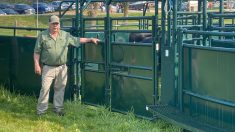The best way to enhance health and reduce mortality in kids and lambs is to ensure adequate consumption of high-quality colostrum, preferably from the herd of origin.
Dr. Robert Van Saun, Pennsylvania State University professor and extension veterinarian, told attendees at Grey Bruce Farmers’ Week that the calibre of dam nutrition from conception to lactation is critical to ensure the health and viability of dam and fetus, as well as reproductive performance during the dry period.
Why it matters: Colostrum for small ruminants requires more research to maximize its efficiency in increasing newborn viability and growth potential, says an expert.
Read Also

Dissolving eartags could make pig traceability easier
A dissolving eartag for market hogs, called Clean Trace could reduce processing challenges and enable more individual management of pigs.
Van Saun said nutrition impacts milk production, yield and composition.
“Every aspect of the profitability capacity of your farm is coming out of that dry pregnant animal’s diet,” he said.
Colostrum is produced before parturition and has antibodies and high fat and protein content. However, once birth signals are triggered, the mammary gland switches to milk production, which dilutes colostrum.
“The longer you wait to harvest (it), the more diluted and milk-like it becomes. So that’s why we focus on the timeframe,” said Van Saun.
A United Kingdom sheep study showed the impact of high and low-energy and protein diets on colostrum production in initial post-lambing hours.
“When you look at the low energy, low protein diet in the first three hours … only 150 millilitres of colostrum were being formed,” said Van Saun, noting the ewe with the high energy/protein diet produced 640 mL in the same time.
Increased colostrum production is required to meet the needs of larger litters within the first two hours of birth.
“If you have a low volume, high quality (colostrum), maybe one lamb or possibly two might get protected but if you’ve got high volume, high quality, then you have better protection for all the lambs.”
The goat industry has ignored the benefits of fresh colostrum because of caprine arthritis-encephalitis concerns. Producers either bypass it or use cow colostrum, replacers or supplements.
Van Saun said initial data from an ongoing study of a 10,000-doe Wisconsin dairy that uses only colostrum supplements shows poor kid colostrum status. He researched one guaranteed kid colostrum substitute that was short 12 grams of the minimum kid requirements for immunoglobulins (IgG).
Ideally, raw colostrum from the dam is best, followed by raw goat and cow colostrum. Heat-treated goat colostrum is the best option if worried about pathogens.
Van Saun said the dam transfers immune cells and various growth factors to fresh colostrum, which is critical in activating a newborn’s immune response and promoting growth.
Ruminant species don’t allow immunoglobulin to cross the placenta, so newborns lack protective antibodies at birth.
However, a dam’s trace elements and macro-minerals do cross the placenta and are concentrated in the fetus’s liver. These are mobilized during birth and when newborns are on a milk-based diet to prevent disease and viruses. If poor nutrition compromises the pregnant animal’s mineral status, offspring can’t build a good immune response without colostrum protection.
“When they consume colostrum … they get a big bolus of vitamin A, D and E,” he said, “(but) only if you’re feeding mom A, D and E during that wintertime. Vitamin A deficiency is highly associated with stillbirths on top of copper (and) selenium deficiency.”
Fetuses enter a state of anoxia, or lack of oxygen, during birth and use stored antioxidants to survive.
“A doe that’s trying to push out four or five kids, those last couple of kids are probably in an anoxic condition for longer,” Van Saun said. “And if they don’t have enough antioxidants on board, that could be a problem.”
Goat kid death loss is 20 per cent, signalling significant opportunities to improve survivability and profitability through colostrum management.
Van Saun said meat and dairy goat colostrum IgG concentrations mirror the significant differences seen in beef and dairy cattle.
A recent Journal of Dairy Science article outlined increasing dairy calves’ “good” level of IgG serum to 18 to 24.9 mg/mL from 10 mg/mL, bringing it more in line with beef, which is 34.4 mg/mL.
He said research is needed to define the adequate volume of high-quality IgG serum and the level of passive transfer required for small ruminants to reach optimal health.
A northern California 900-doe dairy operation with good colostrum management showed had a fresh and frozen colostrum concentration of 21 per cent on the Brix refractometer. In cow and sheep colostrum, that percentage would represent 50 mg/mL IgG, but it translates to 70mg/mL in goats.
The interpretation of goat values requires a different regression line than cattle. The study showed colostrum feedings within two hours of kidding provided 35 grams of total IgG concentration.
“The highest efficiency absorption is somewhere around 22 to 23 per cent. Overall, we had an efficiency of absorption of about 17 per cent, but the range was between just under four to over 50 per cent.”
He said it’s critical that kids receive at least one ounce per pound, or 10 to 15 per cent of body weight in colostrum, within two hours of birth.
“Dairy (goats), we’re down around 18 to 24 mg/mL and I would probably want to be in that 25 to 30 mg/mL range (in a meat goat),” said Van Saun.
A Penn State dairy sheep study of fall lambing Dorsets and spring lambing Hampshires showed 15 mg/mL of lamb IgG serum from samples retrieved for lamb consumption. The samples ranged from 4.3 to 42.5 mg/mL.
Van Saun said until there’s more data, a minimum IgG serum of 15 mg/mL with a total protein greater than six is an ideal starting point, but he’d prefer an IgG closer to 25 mg/mL.













